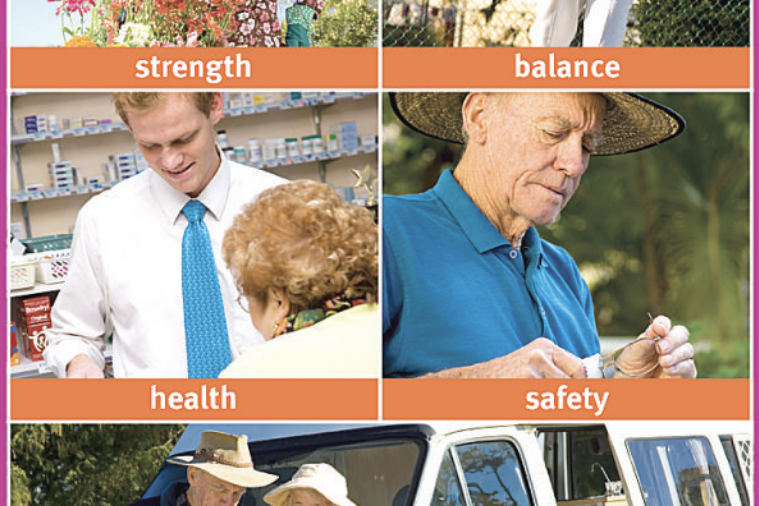News
24 July, 2025
No falls, more freedom
STAYING active, healthy, and independent is possible well into older age — and one of the most effective ways to support this is by preventing falls.

In Queensland, more than 130 older people experience a fall each day that requires medical attention. Many of these incidents result in serious injury, hospitalisation, or long-term loss of independence.
Between 2007 and 2008, falls among Queenslanders aged 65 years and over emerged as a significant public health concern, with data revealing troubling patterns in both frequency and severity.
The majority of falls occurred at home, particularly during the cooler months from May to July, when environmental factors such as wet or slippery surfaces may contribute to higher risk. Slips and trips on level ground were the most common causes of these incidents.
Injuries sustained in falls were most often to the head, hip, and forearm, with fractures — especially hip fractures — being the most frequent and serious outcomes.
On average, each day saw 62 older Queenslanders requiring ambulance transport due to a fall, with the majority of these individuals being over 85 years of age.
Of those, 13 people required treatment in an emergency department, and 35 were admitted to hospital for fall-related injuries.
Hip fractures alone accounted for 10 of these daily hospital admissions, each costing the Queensland health system an average of $15,046.
Falls were not limited to private homes. Hospital environments also recorded 32 falls per day during this period. These incidents were mostly unwitnessed and tended to occur during peak activity times in the morning (between 9 am and noon) and later in the afternoon or evening (between 3 pm and 7 pm).
Tragically, unintentional falls claimed the lives of 493 Queensland residents in 2007, with nearly 95% of these deaths occurring in those aged 65 years and older.
The good news is that most falls are preventable.
According to Queensland Health, the causes of a fall can usually be identified and the sequence of events leading up to the fall can be predicted and therefore prevented.
To reduce the risk, seniors and those who care for them can start by making simple, yet effective changes to daily routines and environments:
Maintaining strength and balance is essential. Health professionals recommend performing targeted exercises — twice weekly if possible — to build thigh and gluteal muscles that help with stability.
Wearing shoes with firm, slightly rounded heels under 2.5 cm, non-slip soles, good grip, and secure fastening can significantly reduce slips or trips (Queensland Health).
Managing health conditions is another key strategy. Regular reviews of medications — especially those that cause drowsiness, dizziness, or altered alertness — can uncover and address fall risks.
It’s also wise to get eyes examined at least annually, use contrast strips on stairs if visibility is poor, and seek professional assessment for hearing, continence, or mobility issues.
A safe home environment matters greatly. Marked steps, ample lighting in bedrooms, bathrooms, and stairways, and removal of trip hazards — like loose rugs or cords — help reduce incidents.
Bathroom aids such as stable shower stools and handrails, properly maintained floors, and clear pathways also contribute to safer spaces.
Supporting healthy ageing is equally important. A balanced diet, staying active most days, attending regular health check-ups, and addressing barriers like falls-related fear or incontinence are foundational to remaining independent.
Following these accessible strategies, Queensland Health has introduced the Stay On Your Feet Toolkit, an evidence-based resource tailored to help anyone working with older adults — from individuals and caregivers to professionals.
The toolkit builds on a four-phase Community Good Practice Model:
Investigate: assess local fall rates, existing services, and readiness to act.
Plan: choose evidence-based interventions, assemble stakeholders, set measurable goals, and develop communication strategies.
Implement: pilot programs, enact initiatives, and monitor progress while keeping stakeholders engaged.
Review: evaluate what was done, measure results, celebrate achievements, and plan the next phase.
The toolkit also includes practical tools and templates — such as community stocktakes, social marketing plans, referral checklists, and clinical evaluation forms — to guide both community-level programs and individual risk management.
With an ageing population projected to more than triple older residents in coming decades and overwhelming costs associated with falls injuries, proactive prevention is urgent.
By combining straightforward personal actions — like exercising, shoe checks, medication reviews, and home safety — with structured community initiatives through the Stay On Your Feet Toolkit, Queenslanders can take tangible steps to help older adults remain safe, healthy, and independent.
For more information on falls, prevention, and the Stay On Your Feet toolkit, visit https://www.health.qld.gov.au/stayonyourfeet

